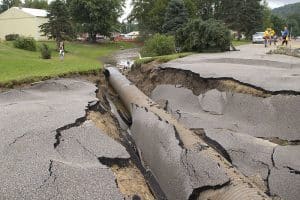This year’s presidential campaign trail has been unique. The two leading candidates challenge convention in numerous ways, and have fostered one of the most heated election years in decades. While many issues and facts have fueled both the passion and the divisiveness of this year’s presidential election, there is one issue on which all parties agree: the urgent need to invest in infrastructure.
Out of Sight, Out of Mind

Because our nation’s water and wastewater infrastructure is buried underground, it is often forgotten. After all, safe, clean drinking water is ours at the turn of the tap, and wastewater disappears instantly with the flush of a toilet. This buried infrastructure is one of the key components of modern-day civilization, without which our society would cease to function properly – if at all.
Alarmingly, our national water and wastewater infrastructure is in desperate need of upgrading. The ASCE 2013 Report Card for America’s Infrastructure gives our water and wastewater infrastructure a D grade, and the EPA notes that about 30% of large system pipes are 40-80 years old, and another 10% are over 80 years old. In the northeast, this statistic only goes up, with some pipes being well over 100 years old. Our nation’s infrastructure is arguably reaching the end of its useful life. Currently, we lose about seven billion gallons of clean, treated drinking water every single day from leaky pipes, which is enough water to supply the daily needs of the entire state of California. Considering that many communities, including the State of California, have been under drought watch for years, this water loss is deeply concerning.
In addition to our nation’s crumbling water infrastructure, many of our nation’s water service lines are made of lead. To avoid catastrophes like the Flint, Michigan lead crisis earlier this year, the lead service lines that are still supplying seven to ten million American homes need replacement. Also, many of our nation’s wastewater treatment plants were constructed following the passage of the Clean Water Act in 1974, and they are now 30-40 years old and very much in need of rehabilitation or replacement.
Where the Presidential Candidates Stand on Infrastructure

To improve our water and wastewater systems before they reach failure, it is imperative that our elected leaders push for legislation to invest in infrastructure. Yet because our nation has so many other pressing issues and needs, our buried infrastructure is often overlooked. However, in the wake of this year’s Flint, Michigan lead crisis, our nation’s water and wastewater infrastructure has come to the forefront of the minds of American citizens and legislators, with some funding and improvement already being implemented. It is crucial that we elect leaders who will continue this momentum.
At the presidential level, both candidates have promised increased funding for our buried infrastructure. Democratic candidate Hillary Clinton has proposed a plan which includes spending $250 billion over the next five years on all types of infrastructure, including not only water and wastewater systems but also roads and bridges, broadband, passenger rail systems, airports, levees, and dams. In addition, her plan includes $25 billion in seed money to establish a National Infrastructure Bank, which would provide funding for local infrastructure projects. She has said that the bulk of her $275 billion plan would be funded by business tax reforms.
Republican candidate Donald Trump has proposed a decade-long, $1 trillion plan that was drafted by economic advisors Peter Navarro and Wilbur Ross. Unlike Clinton’s plan which depends on additional taxes, Trump’s plan relies heavily on private funding and tax credits for investment. Trump’s belief is that taxes collected from laborers and from companies working on these projects would offset any costs incurred by the government in the form of tax credits to investors. In addition, projects that receive tax credits would be required to have a dedicated source of revenue, such as tolls for roads or water bills for utilities, that would guarantee a source of cash flow back to investors and better attract private investment.
Voting for the Future of our Nation

Besides the presidential candidates, there are numerous elections for Senate and Congressional seats that will play a key role in the future of our nation’s infrastructure. Because the president is only as effective as the Senate and Congress that support him or her, it is critical that we as a nation elect legislators who will champion plans of action and funding to rehabilitate and replace our nation’s buried infrastructure both now and in the future. Whether the investment comes from taxpayers, private investors, or a combination of the two, the fact remains that the clock is ticking on our nation’s water and wastewater infrastructure and the time to invest in infrastructure is now. Happy voting!
